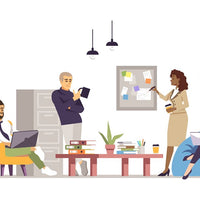
Patience Requires More Than Deciding to Be Patient
“God, grant me patience, and give it to me right now!” This statement may capture our sentiment in response to dozens of situations we face. This is a time of year when our patience can grow thin. We feel the need to move learning along, but not every student may be ready. Or we may be dealing with off-task and low-commitment behaviors that we allow to accelerate our frustration.
When students struggle and fail to make the progress we expect, we can become impatient and press harder in response. Yet, our lack of patience often makes the situation worse. Students become anxious and unable to think clearly and work efficiently. The result can be a descending cycle of frustration and emotional upset, leading to even less learning.
Admittedly, correcting some situations may require more than patience, but without it, progress is likely to be slow and other efforts to correct the situation will suffer. Our patience can offer reassurance and space so that our instruction, coaching, and encouragement can be effective.
Equally important, increasing our patience can improve our mood, deepen our empathy, and strengthen our relationships. Increased patience makes us better collaborators and coworkers. Patience can also help us to be more successful in reaching goals and achieving long-term career success.
However, patience is not just a matter of deciding to be patient. While some people have a natural tendency to be more patient, patience is a skill that can be developed and strengthened with strategy and practice. Of course, we also need to be patient with ourselves as we work to strengthen and expand our ability to listen, focus, and encourage our students and their learning. If patience is something we want to build, here are seven actions worth considering:
- Practice pausing. The space between what happens and how we choose to respond is the door to practicing patience. The good news is that we don’t have to pause long. We used to think that we needed to count to ten in order to allow ourselves time to get hold of our emotions and craft a productive response. However, experts say that if we give ourselves just two seconds, our “gut” response will pass, and we will be able to avoid an emotional eruption.
- Slow down. Practicing patience is most difficult when we are in a hurry. Rather than allow ourselves to feel rushed, we can consciously let go of our urgency and slow our thinking. Often, the simple act of slowing down allows us to better understand what is happening and how we are reacting. It can also help us to see options and opportunities that we otherwise are likely to miss.
- Focus on breathing. Focusing on our breathing and choosing to slow the pace and deepen our breaths can break the tension and frustration we feel and allow us to think and make better decisions about what we need to do next.
- Commit to listening. Listening is among the most powerful strategies for building patience. It shifts our focus from what we are feeling and what we want to do to giving our attention to someone else. When we are really listening, we also often gain new information about the other person and situation. Listening can dispel faulty assumptions, inform our understanding, and keep us from saying or doing things in our frustration that we later regret.
- Be present. When we focus on what is happening and do not allow our attention to be elsewhere, we are more likely to pick up signals and clues that can help us to better understand the situation and what is needed. On the other hand, when we are preoccupied by what should be happening or needs to happen next, we can find it difficult to be patient and understanding.
- Identify triggers. There are types of incidents, certain circumstances, or even people who are more likely to try our patience. We can keep track of situations in which we struggle most and search for patterns that may point to common sources of our frustration. Knowing the times, conditions, and people that can lead us to struggle can offer useful insights about where to place our efforts in circumstances when we need to prepare to be patient.
- Practice acceptance. Being willing to accept circumstances as they are and not allow them to drive our impatience may be the most difficult strategy for practicing patience, especially if we have a strong desire to control. Yet, becoming impatient with things over which we have no control is a waste of energy. When we feel our impatience begin to grow, we can ask ourselves, “Is this something I can control or change?” If not, we might choose to accept the situation and let it go or find something else to focus on that will not lead to frustration and impatience.
Growing our patience offers multiple benefits for us and others in our lives. When we free ourselves from frequent impatience, we recapture energy that we can allocate to other, more productive endeavors. Meanwhile, those around us are subjected to less tension and gain a more patient teacher, colleague, friend, or family member.

Take Your District and School Professional Learning to a New Level!
learn more
- Teachers
- Administrators
- Paraeducators
- Support Staff
- Substitute Teachers

- Teachers
- Administrators
- Paraeducators
- Support Staff
- Substitute Teachers






Leave a comment
Your email address will not be published. Required fields are marked with *